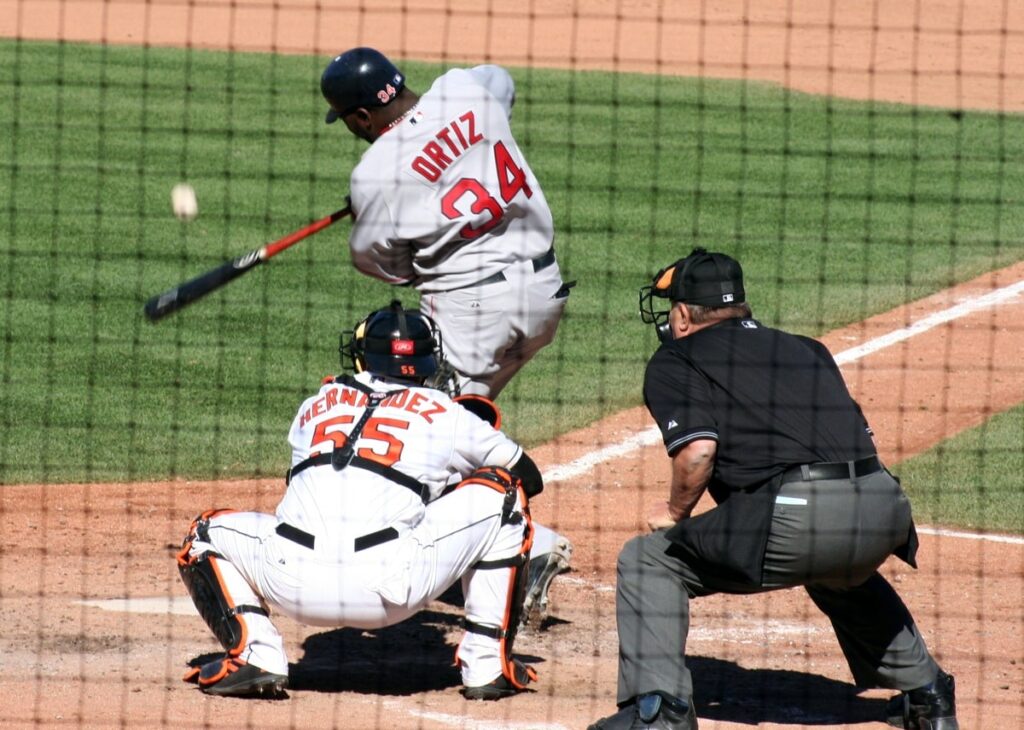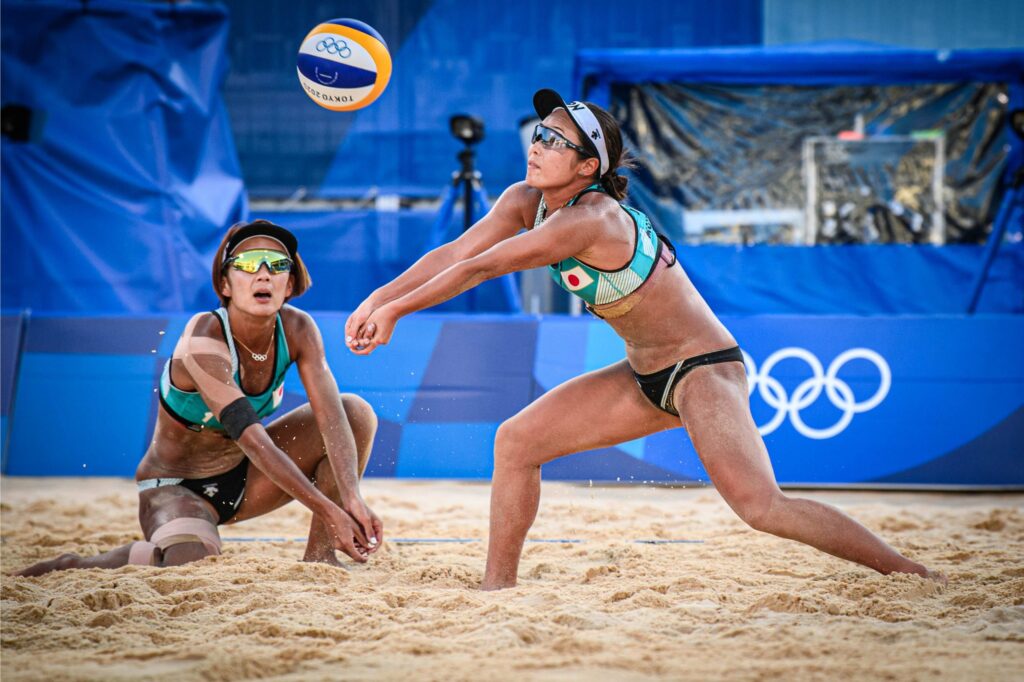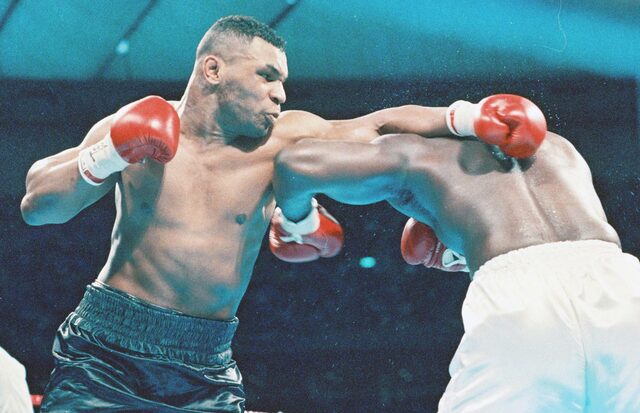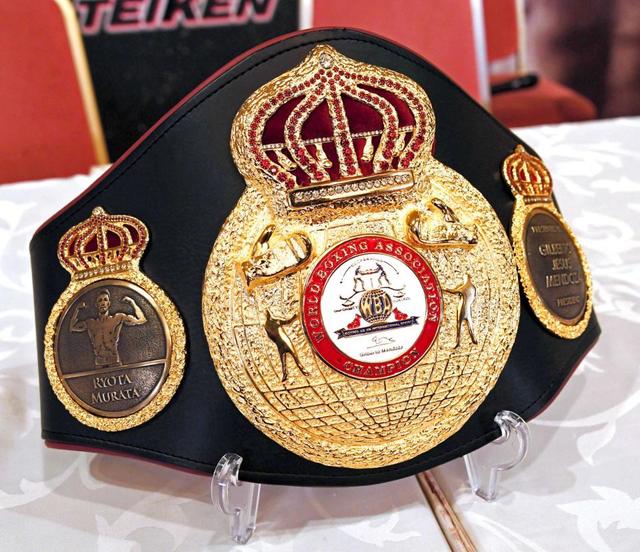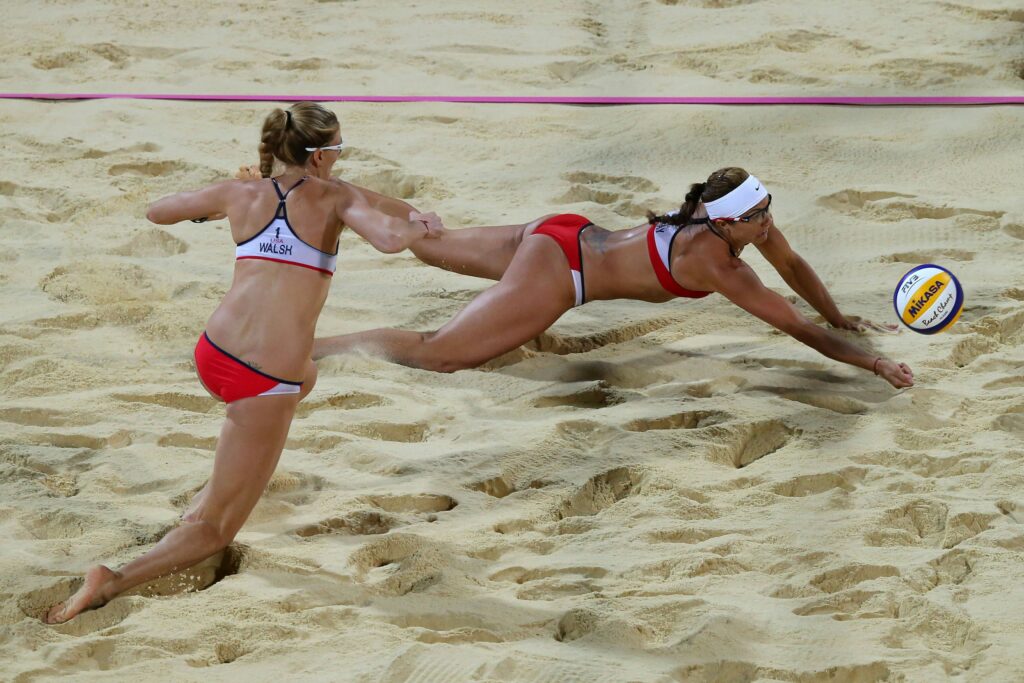
Beach volleyball is played not only on summer beaches but also in many other places around the world.
Court size is a very important factor in enjoying this exciting sport.
With the correct court size, you can enjoy playing games that follow the rules and improve your technique.
But knowing the appropriate court size is useful not only for formal matches, but also for casual play with friends and family, or just practicing in your own garden.
This article covers everything you need to know about beach volleyball court sizes, from official beach volleyball court sizes to how to easily set them up at home or in the park, to tips on sizing for kids and beginners.
We will deliver useful content for all beach volleyball fans, from those who have just started playing beach volleyball to experienced players who want to practice more seriously.
So, let’s step into the world of beach volleyball courts together.
目次
- 1 Official size of beach volleyball court
- 2 Tips for making a beach volleyball court at home or in the park
- 3 Court markings for beach volleyball
- 4 Beach volleyball court size adjustment
- 5 How to best use a beach volleyball court taught by professionals
- 6 Frequently asked questions: Beach volleyball court size
- 6.1 Q1. What is the official size of the beach volleyball court?
- 6.2 Q2. Can the coat size be made smaller?
- 6.3 Q3. Is there a need for a free zone around the court?
- 6.4 Q4. How deep does the sand need to be?
- 6.5 Q5. How do you mark the lines on the court?
- 6.6 Q6. Is it possible to build a beach volleyball court in my garden?
- 7 summary
Official size of beach volleyball court
Beach volleyball is a sport loved all over the world, and in order to fully enjoy its charm, it is important to know the official rules and court sizes.
There are official standards for beach volleyball court sizes set by the International Volleyball Federation (FIVB).
Here we will explain the details and importance of the official sizes of beach volleyball courts.
Official size of beach volleyball court
Beach volleyball courts are rectangular, and for official international matches, the following dimensions are standard:
- Length : 16 meters
- Width : 8 meters
This size is used in two-person beach volleyball. A free zone of at least 3 meters must be maintained around the beach volleyball court, and ideally a minimum of 5 meters is recommended.
This is to ensure players have enough space and stay safe when chasing the ball.
Coat sand depth
Beach volleyball courts are made of sand, and the depth of the sand is determined by international standards.
The depth of the sand throughout the coat should be at least 40 centimeters.
This is important to cushion the impact and prevent injuries when players jump or dive.
Line regulations
The boundaries of the beach volleyball court are marked by a 5 cm wide strip.
These lines must be clearly visible and are usually white or blue.
There is no center line, but when serving, you must serve from the back end line.
Why this size?
Beach volleyball court sizes are carefully determined by the International Volleyball Federation, taking into account the speed of the game, competitiveness, and spectator enjoyment.
If the court is too wide, there will be less interaction between players and the tempo of the game will slow down. Conversely, if it’s too narrow, you’ll limit your range of play and lose strategic variety.
Current sizes are designed to optimally balance these factors.
Understanding the official size of a beach volleyball court will help you better understand the nature of the sport and help you enjoy beach volleyball at home or at a local facility.
By following these standards, you will be able to practice under conditions similar to those in a formal competition, which will lead to improved technique.
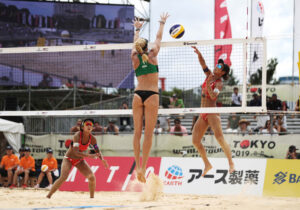
Tips for making a beach volleyball court at home or in the park
Building a beach volleyball court at home or at the park is a great way to make playing beach volleyball even easier.
However, correct coat size and preparation is important.
Below, we will explain in detail the basic points to consider when making your own beach volleyball court, how to measure it, and the tools you will need.
Beach volleyball court size and how to measure
First, let’s use the official dimensions of a beach volleyball court (16 meters long and 8 meters wide). Once you have chosen where you will build your coat, follow these steps to accurately measure it:
- Prepare your measuring supplies : Gather measuring tape or rope, pegs (or sticks), and spray paint or chalk.
- Setting the base point : Choose a corner of the court as the base point and mark it with a peg.
- Measuring the length : Measure a point 16 meters from the base point using the measuring tape and mark it with a peg.
- Measuring the width : Similarly, measure a point 8 meters vertically from the base point and mark it with a peg.
- Complete the square : Measure at right angles from the first two points you marked, then mark the remaining two points with pegs to complete the square.
- Draw the border : Draw a border with spray paint or chalk based on the points where you placed the pegs.
Necessary tools and materials
- Measuring tape : Required to accurately measure the size of your coat.
- Rope : Used to indicate the outer frame of the court.
- Pegs or sticks : Used to mark each corner of the court.
- Spray paint or chalk : Use to draw borders. Spray paint is suitable for sandy areas and chalk is suitable for grassy areas.
- Sand : If possible, cover the surface of the court with a good amount of sand. Especially when making it in your own garden, the layer of sand should be 40 centimeters thick.
- Net and pole : Beach volleyball net and the pole that supports it. The official standard for net height is 2.43 meters for men and 2.24 meters for women.
important point
- Location selection : When choosing a location for your court, consider safety and make sure there is enough space.
- Surroundings : Make sure there are no breakable objects nearby and that there is sufficient space around the perimeter of the court, as the ball may fly off.
Building a beach volleyball court at home or in the park is a great way to make beach volleyball an accessible sport.
Create a safe and fun beach volleyball environment by following the points above.

Court markings for beach volleyball
When setting up a beach volleyball court, it is important to draw the lines accurately.
This ensures that the game is played fairly and according to the rules.
Below are the steps to accurately mark your beach volleyball court.
1. Preparation of necessary materials
- Line marking tape : Choose one that is weather resistant and has a clear color. Generally white is used.
- Measuring tape : Required to measure the dimensions of your coat.
- Pegs or sticks : Used to mark corners of the court.
- Hammer : Used to drive pegs.
- Corner flags or markers : Mark each corner of the court.
2. Measure the coat dimensions
- Measure the exact length (16 meters) and width (8 meters) of the court and use pegs to mark each corner.
3. Border marking
- Apply line marking tape from each corner marked using pegs. Use pegs or special fixing devices to ensure the tape is securely fixed to the ground.
- Secure the beginning and end of the line with pegs to keep the tape taut. Be careful not to let the line sag or bend.
- Beach volleyball does not have a center line, so care must be taken when marking the serve area. The serving area is located behind the back line and at a certain distance from the edge of the court. This area can be marked with specific markers.
4. Corner flag installation
- Place corner flags or clear markers at each corner of the court to clearly indicate the limits of the court. This is a necessary element, especially in official matches.
5. Final check
- Make sure all lines are drawn correctly and all markers are in the correct position. Adjust the line if necessary.
Beach volleyball court markings are fundamental to keeping the game fair and ensuring players play according to the rules.
Careful execution of these steps will result in accurate coat marking.

Beach volleyball court size adjustment
Beach volleyball is a sport that can be enjoyed by all ages and skill levels, but the official court size can sometimes feel too large, especially for children and beginners.
Therefore, by practicing on a smaller court, you can make it easier to learn the basics of play and improve your technique while having fun.
Here we will explain how to adjust the size of practice beach volleyball courts for children and beginners.
Practice court size for children and beginners
The official beach volleyball court is 16 meters x 8 meters, but the following sizes are recommended for children and beginners:
- Length : 12 meters
- Width : 6 meters
This size is meant to encourage players to easily catch up to the ball and continue rallies. There is also plenty of space to learn basic techniques such as serving and receiving, making it suitable for learning the basics of movement and positioning necessary for the game.
How to adjust coat size
- Measuring and marking : First, decide where you want to set up your practice court and use a measuring tape to measure an area of 12 meters by 6 meters. Mark the corners with pegs or sticks to create the shape of the court.
- Setting lines : Use line tape, sand, or natural materials to draw lines to define the boundaries of your practice court. It is best to choose bright colors and materials to make it easier for children and beginners to understand.
- Adjusting the net : The height of the beach volleyball net is also recommended to be adjusted for children and beginners. For both men and women, setting the height to approximately 2 meters will make the game easier.
important point
- Ensuring safety : When sizing the court, make sure there is enough space around the playing area to ensure safe play.
- Flexibility : Adjust court size and net height according to player age and skill level. The aim is for players to improve their technique while having fun playing beach volleyball.
By installing a beach volleyball court for children and beginners, we can provide a more friendly and learning environment.
This will allow you to master the basics of beach volleyball and get the most out of the game.
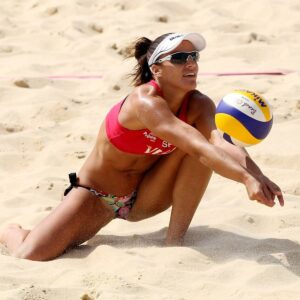
How to best use a beach volleyball court taught by professionals
Learning how to best utilize a beach volleyball court is critical for players to develop their technique and competitiveness.
Here, we will introduce the best ways to use beach volleyball courts, from training to competitions, based on advice from professional beach volleyball players and coaches.
1. Basics of beach volleyball training
- Practice basic techniques : Repeat and practice basic beach volleyball techniques such as serve, receive, set, attack, block, and dig. We especially focus on control and accuracy, ensuring each shot is consistent.
- Conditioning : Movement on sand is different than on land and has its own unique stresses. For this reason, we train to strengthen the legs and hips, improve balance, and develop endurance to create a body that can handle the movements unique to beach volleyball.
2. Practice tactics and strategy
- Positioning and Communication : Develop effective on-court positioning and communication skills during play to improve coordination with partners.
- Opponent analysis : Observe the characteristics of the opposing team during pre-game warm-ups and early stages of the game, and plan your tactics. Establish an approach to exploit your opponent’s weaknesses and a play style that leverages your team’s strengths.
3. Match-style training
- Simulation games : It is important to train in a format that simulates a real match to get used to the pressure of the match. The rules are the same as in matches, including scoring format, order of serve, change of ends, etc.
- Specific situation practice : Set up a specific situation that often occurs in a match (for example, serving in a tense situation, playing with the wind in mind, etc.) and practice how to deal with it.
4. Mental training
- Strengthening concentration : In beach volleyball, split-second decisions can determine victory or defeat, so training to increase concentration is important. Incorporating meditation and specific concentration exercises can help.
- Positive thinking : Maintain a positive attitude toward various situations that occur during a match and perform mental training to increase self-motivation.
5. Recovery and physical condition management
- Proper recovery : Stretching, proper nutrition, and getting enough rest after training or a game will help your body recover.
- Regular physical condition checks : To avoid overuse due to excessive training, constantly check your physical condition and adjust training intensity as necessary.
When using a beach volleyball court, keeping these points in mind and engaging in effective training and competition will lead to improved technique and stronger competitiveness.
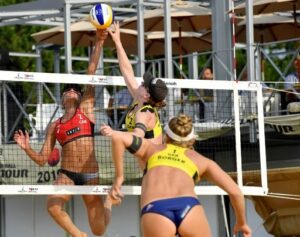
Frequently asked questions: Beach volleyball court size
Many beach volleyball players and event organizers ask us about the size of a beach volleyball court. Below are frequently asked questions and answers on this topic.
Q1. What is the official size of the beach volleyball court?
A1. The official size of a beach volleyball court is 16 meters long and 8 meters wide. This is the standard size used in international two-person beach volleyball matches.
Q2. Can the coat size be made smaller?
A2. It is common to adjust the size of the court for children, beginners, or for practice. For example, a size of 12 meters long and 6 meters wide may be recommended for children and beginners. However, for official matches, international standard sizes must be adhered to.
Q3. Is there a need for a free zone around the court?
A3. Yes, a free zone is required. It is recommended that there be a free zone around the beach volleyball court of at least 3 meters, ideally 5 meters or more. This is to ensure player safety and provide enough space during the game.
Q4. How deep does the sand need to be?
A4.The sand depth for the entire court must be at least 40cm. This is to cushion the impact when players jump or dive, reducing the risk of injury.
Q5. How do you mark the lines on the court?
A5. The border of the court will be marked by a clear line with a width of 5 centimeters. These lines are usually drawn using white or blue tape or paint. Lines must be clearly visible to players.
Q6. Is it possible to build a beach volleyball court in my garden?
A6. Yes, it is possible. However, you will need enough space to set up an official size court. It is important to ensure size, sand depth, and a safe free zone. If you have a small space, consider adjusting the size and installing it.
These questions and answers are intended to answer basic questions about the size of a beach volleyball court.
By creating an accurate gaming environment, you can improve the quality of play and enjoy sports safely.
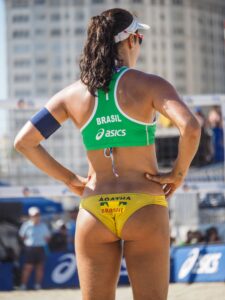
summary
Beach volleyball is a sport loved all over the world, and the correct court size and setup is essential to keeping the game fun and fair.
This guide details basic beach volleyball court design, sizing, marking methods, and frequently asked questions.
The main points are:
- The official size of a beach volleyball court is 16 meters long and 8 meters wide, but courts that are 12 meters long and 6 meters wide are also suitable for children and beginners.
- Court markings will be made using 5cm wide tape or paint to ensure clear identification for players.
- The depth of the sand must be at least 40 centimeters, which is important to ensure player safety.
- The free zone should be at least 3 meters, ideally 5 meters or more, giving players space to move freely.
- The size of the court can be adjusted flexibly to suit the player’s skill level and intended use. This will allow more people to enjoy beach volleyball.
In order to enjoy beach volleyball, accurate court settings are important.
Use this guide to design the right beach volleyball court and create the perfect playing environment, from training to competition.
Appropriate court preparation is essential to ensure player safety and encourage technical improvement.
Learn the basics of beach volleyball and enjoy this wonderful sport in a fun and safe manner.
